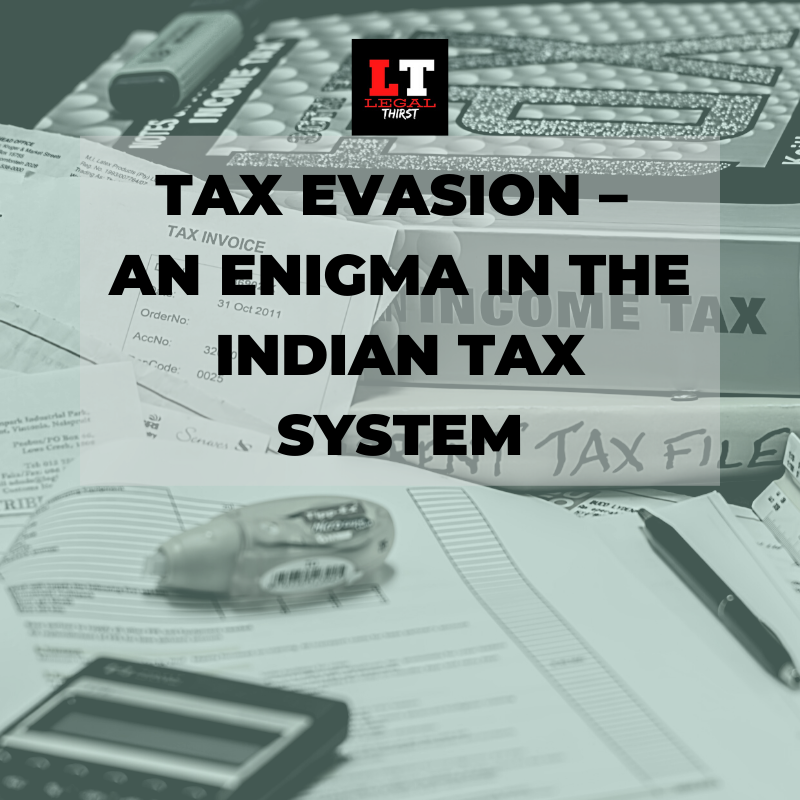This Article on TAX EVASION – AN ENIGMA IN THE INDIAN TAX SYSTEM is written by Sahil Mishra, Legal Researcher, and Content Writer at LegalThirst.com. He is a Law Student at Llyod Law College, India.
Table of Contents
INTRODUCTION
India is the country with the second largest population in the world; still, the tax revenue that India incurs, both at the center and state level; is worth about only 17% of the GDP; which is equivalent to the small island countries like Honduras and Burkina Faso. Only 1.7% of the Indians pay taxes which is in no doubt, a shocking figure.
Article 265 of the Constitution of India; asserts the power to the Centre and State governments to levy and collect taxes; on its subjects through which the income of the government is generated; which is further used in order to boost the economy and social welfare schemes. The collection of tax has been divided among the three fragments of the government. The central government has the authority to collect taxes; pertaining to Income tax, Custom Duties, Central Excise, Sales, and Service Tax. Whereas, the state government is empowered to collect; Sales Tax (intrastate), Stamp Duty, Land Revenue, Duty on Entertainment, State Excise, Tax on the profession, and Callings. And at last, the local bodies are having the authority to levy a Property tax, Market tax, Octroi, etc.
Meaning
Tax Evasion is the illegal evasion of taxes which often entails taxpayers deliberately; misrepresenting the true state of their affairs to reduce their tax liability; and surely includes dishonest tax reporting. In simple terms, it is the mechanism; that may be opted by an individual, company, or corporates, trusts, corporations, etc; to defy the actual income by illegal or unfair means in order to pay less tax or no tax at all. One of the major problems in India pertaining to taxation is that; people try to avoid paying taxes and for compliance with that; they take illegal measures to minimize their tax liability. ‘Tax Evasion’ is one of such measures which aids in evading taxes by the means of showing lesser profits; making misrepresentations to the authorities, also via smuggling.
Comparison with Tax Avoidance
On the other hand, Tax Avoidance is a different approach made by the people for attaining the same objective; that is to incur less tax liability, but via a different mechanism. Tax Avoidance is the legal usage of the tax regime; or structure in a single territory to one’s own advantage to reduce the amount of tax; that is payable by means that are within the law.
These two terms may sound synonyms to each other but are not. Some of the major differences between Tax Evasion and Tax Avoidance are;
- Tax avoidance is a legal approach, whereas tax evasion is not justified in the law.
- Consequences are deferment of taxation liability in tax avoidance but in tax evasion, penalty or imprisonment shall be awarded.
- Tax avoidance aids in taking advantage of the loop-holes in the laws. Whereas tax evasion is the deliberate manipulations in accounts that result in fraud.
SOME PUNISHMENTS & PENALTIES PERTAINIG TO TAX EVASION
- If the person fails to file his/her income tax return; before the due date required under Section 139(1) of the Income Tax Act, 1961; the assessing officer can impose a fine up to 5000 INR or more.
- As per Section 140 A(1) of the Income Tax Act, 1961, if a taxpayer fails to pay self-assessment tax/interest/fee; then he can be declared as a defaulter under Section 221(1) and will be held liable to pay penalty.
- If a taxpayer is issued a demand notice for the payment of tax; then the person has to pay the requisite amount within a 30-days period; failure to do so will invoke a penal trial against such person and fine too.
- Failure to comply with the Income-tax notice will enable the assessing officer; to send notice to the defaulter under Section 142(1) and 143(2) of the Income Tax Act, 1961 seeking to;
- File income tax return
- To furnish the details of all the assets and liabilities, in writing.
- Concealment of actual income to evade taxes is dealt with under the Income Tax Act, 1961. As under Section 271(c), there is a 100% to 300% penalty of the tax evaded if someone is caught concealing tax.
MAJOR INADEQUACIES IN THE TAX STRUCTURE OF INDIA
One of the landmark reforms that the government made was in “Goods and Service Tax (GST)” in 2017, which brought several indirect taxes under a single unified tax for the whole nation; and was chargeable only on consumption of goods or services. Despite making several reforms in the taxation structure of India; still there lie some defects in the system which seriously need an alteration as only it may attract people to file their tax returns and pay taxes. Some of the major defects are as follows;
High Rate and Low Yield Direct Taxes
The rate of direct taxes is very high in India; that people avoid paying taxes via managing their accounts/affairs to sustain the least tax liability; or opt for the alternative that is to evade taxes. In 1950, the tax rate on income was highest in the world; even today after reducing the rates; India is at the top with the highest tax rates.
Low Contribution of Income-tax
Despite the fact of having the highest tax rate on income; India gains very less from the tax imposed on incomes. Tax evasion is the reason behind the issue. The exemption limit in income tax rates has been raised from time to time; but the national and per capita income has failed to cope proportionally. Consequently, the majority of the people became able to escape the tax-net; by any means, and the contribution of income tax declined constantly.
Double Taxation of Dividends
Companies pay corporation and other taxes to the government and a portion of the net profit; after being taxed, is distributed to shareholders as ‘dividends’. Again a portion of such dividends is taxed in a form of personal income tax; which decreases the savings of those who pay tax on dividend income; and companies struggle in raising their financial resources on large scale. Also, this contributes to industrial stagnation due to the high rate of tax and slow growth of corporate capital.
No Agricultural Income Tax
Since agriculture comes under the state subject, taxation on agricultural income has not been possible at the center level. In spite of the fact that the agricultural sector dominates the Indian economy; as well as employs 43% of the workforce in the nation; but has failed to contribute to the government’s tax revenue.
Too Much Reliance on Indirect Tax
The percentage contribution of direct taxes has declined over the few years because of progressive contribution in indirect taxes. This reduces the revenue of the government as direct taxes are levied on according to the income levels; which aids in generating the revenue at the central level.
ABSTAINANCE FROM PAYING TAXES; REASONS
Dissatisfaction among the people
Most of the high-tax countries invest a huge sum in providing free and quality education, healthcare; and other social security schemes, unlike in India; where a person pays tax and also spends a huge amount on the healthcare, education of the children. According to World Bank Data of 2016, 33% of admission were enrolled at primary level in private schools in India; and 51% at the secondary level in private schools.
Along with education, healthcare is also one of the biggest issues in the nation. Government spending on healthcare is very low; India spends only 25.4% on healthcare-related services. 64.6% of the health-related expenditure was borne by the citizens; according to the WHO report.
A taxpayer doesn’t get many other facilities which are basic necessities for which he pays tax, such as;
- Home security
- Clean water at home with sufficient supply
- 24×7 power supply
- Good infrastructure
- Proper sanitization, Hygiene, and healthcare
High rates of Income-tax
However, it should be kept in mind that India is a low-income country; and even at this stage if the government levies huge tax rates on people’s income; then it would only increase the cases of tax evasion or avoidance.
No uniformity in the tax rates
As the income tax rates have different criteria of rates according to the net income of a person; it provides a various exemption to those who do not fall in such criteria which provoke unrest among the people; as it is charged on the income only. Thus there should be a uniform rate for income tax, which will cover every individual under the tax-net.
The multiplicity of taxes
Also, the number of taxes means more complexity and harassment which leads to corrupt practices such as tax evasion. And in turn, these situation demotivates a law-abiding person to undertake the same way of avoiding tax liability.
Disclaimer: The opinions and views in the articles and research papers published on this website; are personal and independent opinions of the author. The website is not responsible for them.
Legal Thirst has created a telegram group for exchanging legal knowledge, Events, and various opportunities.
You can click on this link and join:
Follow Legal Thirst on Instagram and Subscribe to our YouTube channel for more amazing legal content.



